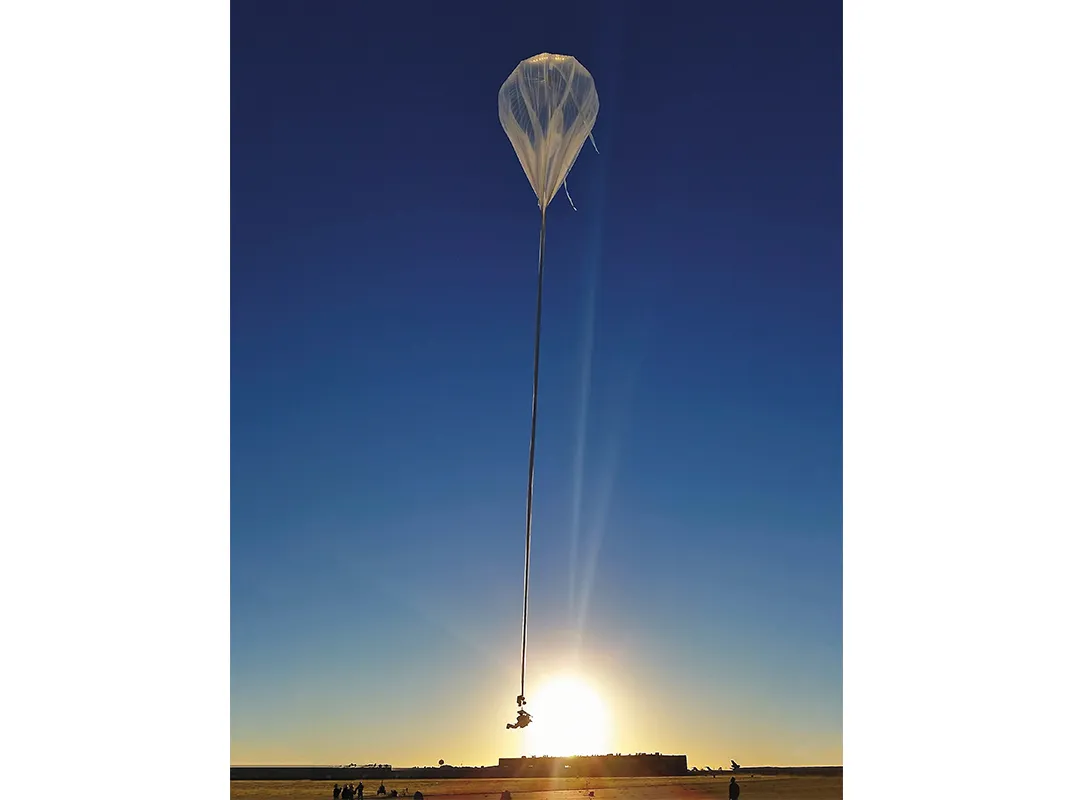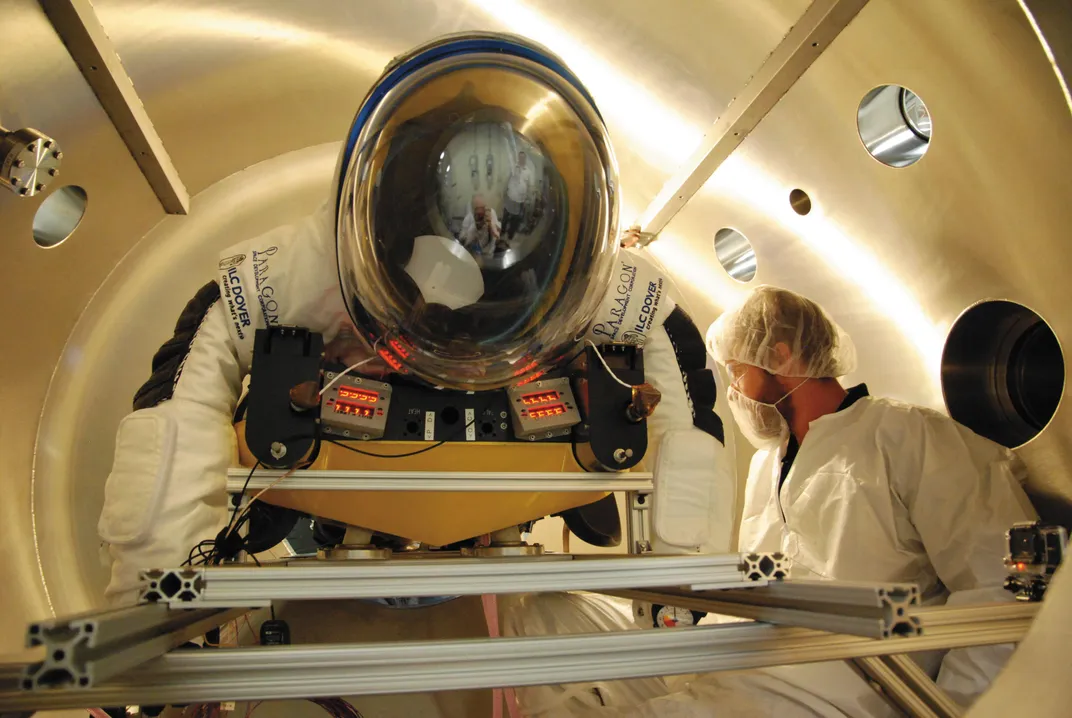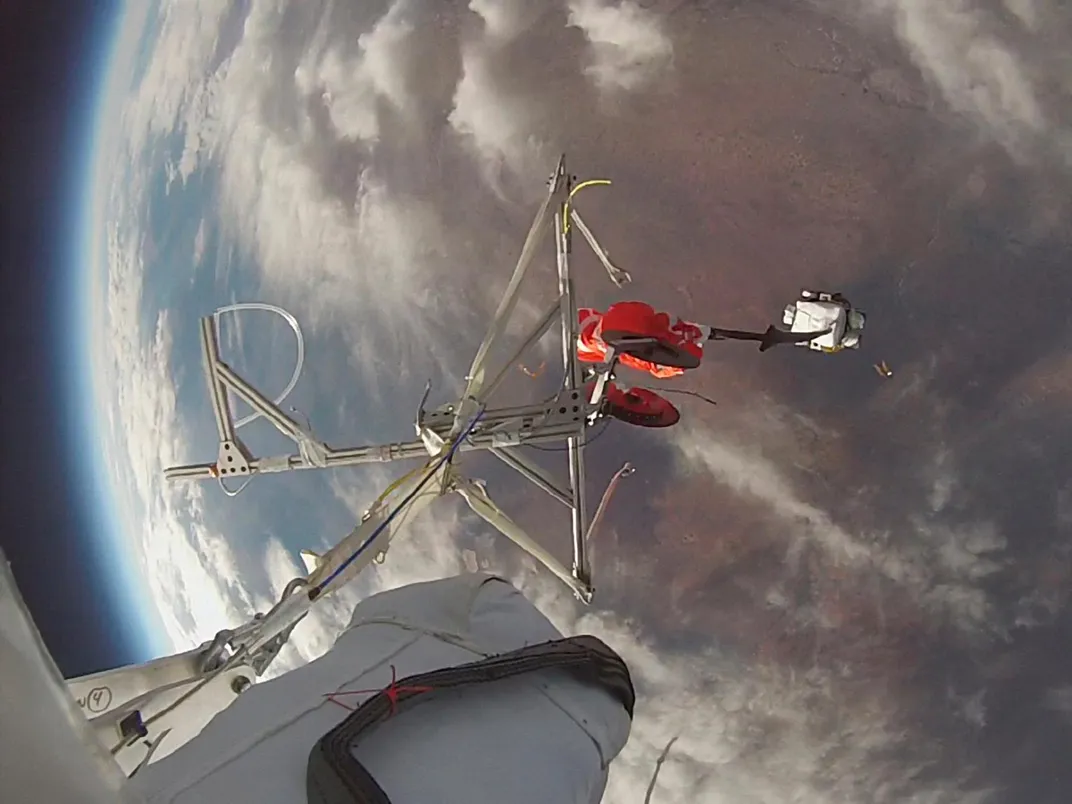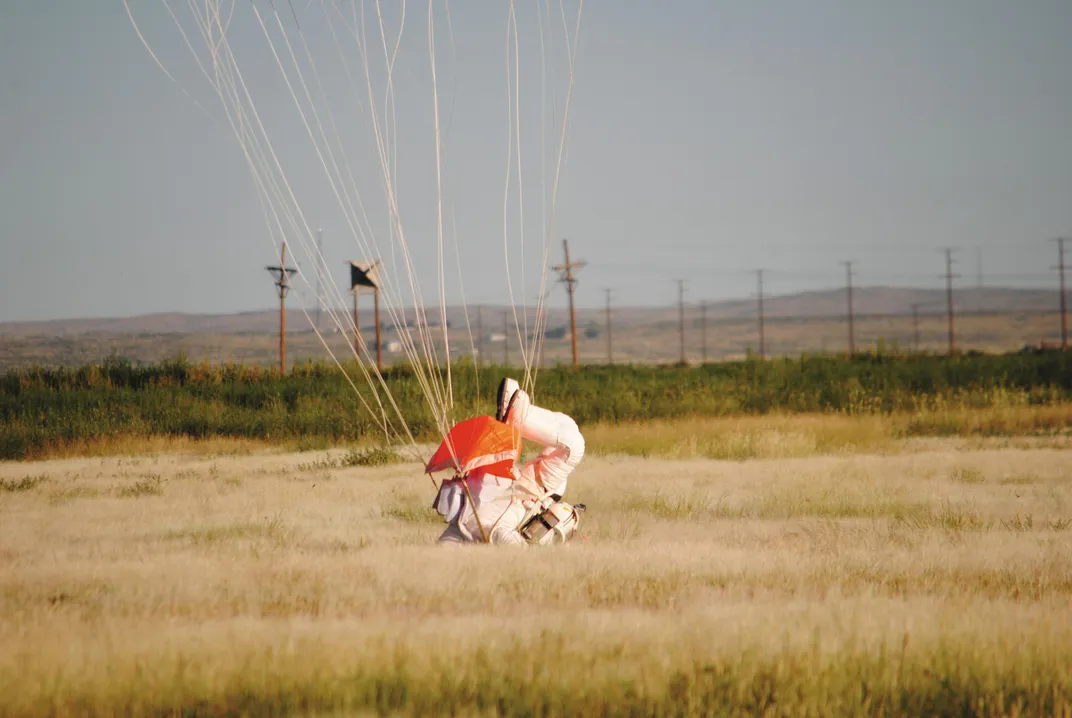The Highest Jump
The computer scientist who pulled off a world-record skydive is still wondering: Could it be done from orbit?
/https://tf-cmsv2-smithsonianmag-media.s3.amazonaws.com/filer/f5/c0/f5c0f562-0c0f-498a-875b-12525fbb49ea/eustace_jump.jpg)
There’s a reason you may not recognize Alan Eustace’s name. Despite the fact that the 60-year-old retired Google executive holds the current record for the highest skydive—a milestone he achieved in 2014 by ascending via balloon to 135,899 feet and returning safely with little more than a spacesuit and a parachute—the jump didn’t get the same massive media attention that swarmed the previous record holder, Felix Baumgartner. That’s no accident: Eustace wanted it that way.
As he told an audience last year at the National Air and Space Museum (where his spacesuit is now on display at the Steven F. Udvar-Hazy Center in Virginia), his motives for the jump were not fame or prestige, but the satisfaction of having sorted out some fairly hairy engineering problems. That’s partly how he persuaded serious space engineers to join his team.
“As much as anything, he was interested in the learning curve,” says Taber MacCallum, who served as Eustace’s safety officer and is now chief technology officer at World View, a company trying to open the stratosphere to tourists. “It was just a really, really hard problem. And it seemed like as the problems got harder and the challenges got greater, Alan got even more into it.”
An avid skydiver and pilot, Eustace had in late 2010 just finished a pet project proving that one could skydive from a Gulfstream 550 business jet (someone happened to ask him if it was possible, so he spent several years figuring out how to prove that it was, by doing it—this is something of a pattern in his life). His friend Luigi Cani, a master skydiver, was thinking of breaking Joe Kittinger’s 1960 freefall altitude record and asked Eustace to advise him on the best life support system to use in the stratosphere. “If it was me, I wouldn’t even use a capsule,” Eustace said.
All previous balloon ventures had relied on capsules or gondolas to convey people to the stratosphere, but Eustace believed the trip could be made simpler. His instinct was that there must be a way to “scuba the stratosphere” by carrying everything necessary for survival at the edge of space in a single, wearable system. Long story short, Cani’s funding fell through, and the problem was still nagging Eustace. So, just like that, he set out to revolutionize high-altitude travel.
He began by calling MacCallum, who at the time (October 2011) was running Paragon Space Development Corporation, a contractor specializing in life support systems for extreme environments. It turned out that MacCallum had also been pondering the prospect of a new kind of vehicle tailor-made for the stratosphere, with the goal of starting a high-altitude tourism operation. The two hatched a plan to develop, test, and prove a totally new system by way of a spectacular, record-breaking space jump. They called the project StratEx.
Around the same time, Felix Baumgartner and his Red Bull-sponsored team were revving up for their own record-breaking jump. Worried that the kind of publicity that Red Bull drew would make him more likely to cut corners—the show must go on, after all, and when the world is watching, no one wants to delay a launch—Eustace chose to fund the project himself and assembled a team that vowed to maintain secrecy.

His first challenge was persuading his wife to let him freefall from 25 miles up. Perhaps hoping to call his bluff, she insisted he make arrangements for his death, write his own obituary, and record “in case of” videos for their two children. All of which he did, before happily setting off to build his spacesuit.
The idea was to get rid of all the extra baggage used by previous visitors to the stratosphere—namely, the vehicles they rode in for the ascent. “When you look at the failures that have occurred [in past manned high-altitude balloon missions], they all boiled down to the interface between the capsule and the person in the suit,” says MacCallum. For example, amateur space jumper Nick Piantanida would have broken Kittinger’s record in 1966, but couldn’t disconnect from his oxygen tank, which was attached to the capsule. So Eustace decided to bypass the idea of a capsule altogether. “The thought was that if the suit is good enough to go down, let’s make it good enough to go up,” says MacCallum.
In some ways, that decision gave the team more options. Baumgartner’s suit allowed him only about 15 minutes of oxygen once he left his capsule. If for some reason his main chute were to open early, making the descent much longer, he would have to cut himself loose, freefall, and use his backup chute to get down before he ran out of air. Doing without a capsule “was not just simpler, it was not just cheaper, but it was much less dangerous,” Eustace says.
With the entire life support system built into the suit (the soft parts of which were made by ILC Dover, the company that makes NASA’s spacesuits), the interface between Eustace and balloon was now, literally, a hook. It had two configurations: Stay attached or let go. And once he detached from the balloon, Eustace’s suit became his only way home. “It’s essentially a spacesuit and a glider and a supersonic dart all in one vehicle,” says MacCallum.
In October 2012 Baumgartner made his jump from 127,852 feet and broke Kittinger’s record, an accomplishment Eustace says took the pressure off his team and let them focus on their own mission. They felt confident they’d be able to beat Baumgartner’s altitude record when the time came. “It didn’t actually matter what altitude they went to,” Eustace said during his Museum talk last year. “We just ordered a balloon that would go higher.” (In general, the larger the balloon, the higher it goes.) The Fédération Aéronautique Internationale, the body that officially documents aerospace records, requires a two percent margin to beat a previous record, so the team set their sights on around 8,000 feet higher than Baumgartner’s jump.
The project was not without difficulties. During the first test jump, as Eustace exited the aircraft, the antenna used for his communications and GPS location was sheared off. His team drove around the desert desperately trying to find the jumper, and ultimately had to rely on a passing helicopter to spot him.
Even the ground tests produced a few surprises. The liquid nitrogen-cooled walk-in freezer StratEx used to test the suit’s heating system would get so cold that the floor would pop up and make “pinging” noises. Eustace’s visor kept getting so fogged he couldn’t see, a problem that had plagued all previous jumpers. The team regulated his temperature so he wouldn’t sweat as much. And when his handlers had trouble dumping Eustace out the back of an airplane during test jumps, they bolted roller blades to his chest plate to make it easier to get him out the door without damaging the suit.
Then there was the flat-spin problem. A space-suited dummy dropped from a high-altitude balloon in early tests would spin at a rate of 180 revolutions per minute, more than enough to cause a brain hemmorhage and kill Eustace. Normally this effect would be countered by a drogue parachute, a small chute meant to stabilize a falling object, but their drogue wasn’t working at high speeds in the stratosphere. After months of head-scratching and testing, the team finally figured out that the drogue had to be attached as high on Eustace’s body as possible so that he descended supersonically at an angle, with his feet below him. “It sounds easy afterwards,” says MacCallum. “But at the time we didn’t understand that.”
The drogue itself presented perhaps the greatest problem, one that had nearly killed Joe Kittinger back in 1959. Because there’s so little air in the stratosphere, for the first part of one of his jumps, the pilot chute designed to deploy Kittinger’s drogue flapped around uninflated and eventually wrapped around his neck. Without the drogue he went into a serious spin and blacked out, surviving only because his main chute deployed automatically (Baumgartner, who chose to jump without a drogue except as a backup, experienced a similar dangerous spin and was barely able to stabilize himself and avoid losing consciousness). If you try to deploy the drogue late in the jump, when the air is denser, it will rupture, because by that time the guy in the suit is pushing Mach 1.
The StratEx team solved the problem ingeniously. Their drogue deploys at the end of a 10-foot boom made of flexible plastic, which unspools at the time of balloon release and instantly becomes rigid and super-strong. The chute deployed early, while the air was still thin, and the boom kept it away from Eustace, and all without using any actuated parts.
None of this had been done before, but Eustace’s three balloon flights, culminating with the record-setting jump on October 24, 2014, over Roswell, New Mexico, proved that it all worked perfectly. Afterward, Eustace had nothing but praise for the suit, which he called “the most protective environment you’ll ever see.”
In theory, the StratEx system could be used for future high-altitude or space applications, including MacCallum’s new strato-tourism venture. But Eustace says there’s no reason one couldn’t don a suit and make a hang gliding descent from 70,000 feet. Someday, people with the means and the inclination may be able to take a space dive like Eustace’s for fun, although both he and MacCallum say the extensive training that’s required would likely preclude developing a viable business around helping tourists experience high dives.
Could the innovations in the StratEx system someday lead to a bailout system for astronauts? Eustace has thought about it. The idea cropped up sometime after his jump, when someone—this time a child—asked him how high one could go wearing his StratEx suit. He started looking into it, scribbling on napkins and asking around at various space tech companies.

This time the issue isn’t protection from the vacuum of space, but the challenge of entering the atmosphere at 17,000 mph. The system would need some form of heat shield in order to prevent the suit and its occupant from becoming a meteor.
Back in the early space age, General Electric came up with a concept called MOOSE (Man Out of Space Easiest), essentially a one-person life raft equipped with a rocket for de-orbiting and a heat shield. Even its designers saw MOOSE as a last-ditch solution, however, and neither NASA nor the Air Force was interested in developing it.
Eustace imagines something akin to the small, disposable reentry vehicles that NASA and the European Space Agency have proposed as a means to get experiment payloads down from orbit. These inflatable structures—which have gotten as far as preliminary testing—would become hard as rock once filled with gas, and can be coated in ablative material that dissipates heat as it burns off. The idea, says Eustace, is that “you just essentially pump up your reentry vehicle,” climb on, and fire a small retrorocket to point yourself home.
The inflated reentry shield could be shaped to be passively self-stabilizing, and could even be made into a kind of wing, essentially flying down into the atmosphere with enough lift to reduce frictional heat, while also reducing the G-force on the pilot.
Eustace has spent enough time thinking about space rescue to conclude that it is at least plausible. For now, he’s satisfied with that. “I think I’m going to take it and put it in the drawer and…encourage somebody else to do it,” he says, adding that his wife would never agree to let him reenter Earth’s atmosphere in a spacesuit anyway. Besides, he and his band of geek pioneers have already advanced the state of the art. Someone else can pick up the work from here.
Toward the end of his presentation at the Museum last year, Eustace was asked about future applications of the technology he developed. “When scuba diving was popularized with the very first aqualung by Jacques Cousteau, did he have any idea the impact it would have on all of us?” he asked in response. “I don’t think the answer’s yes.”


